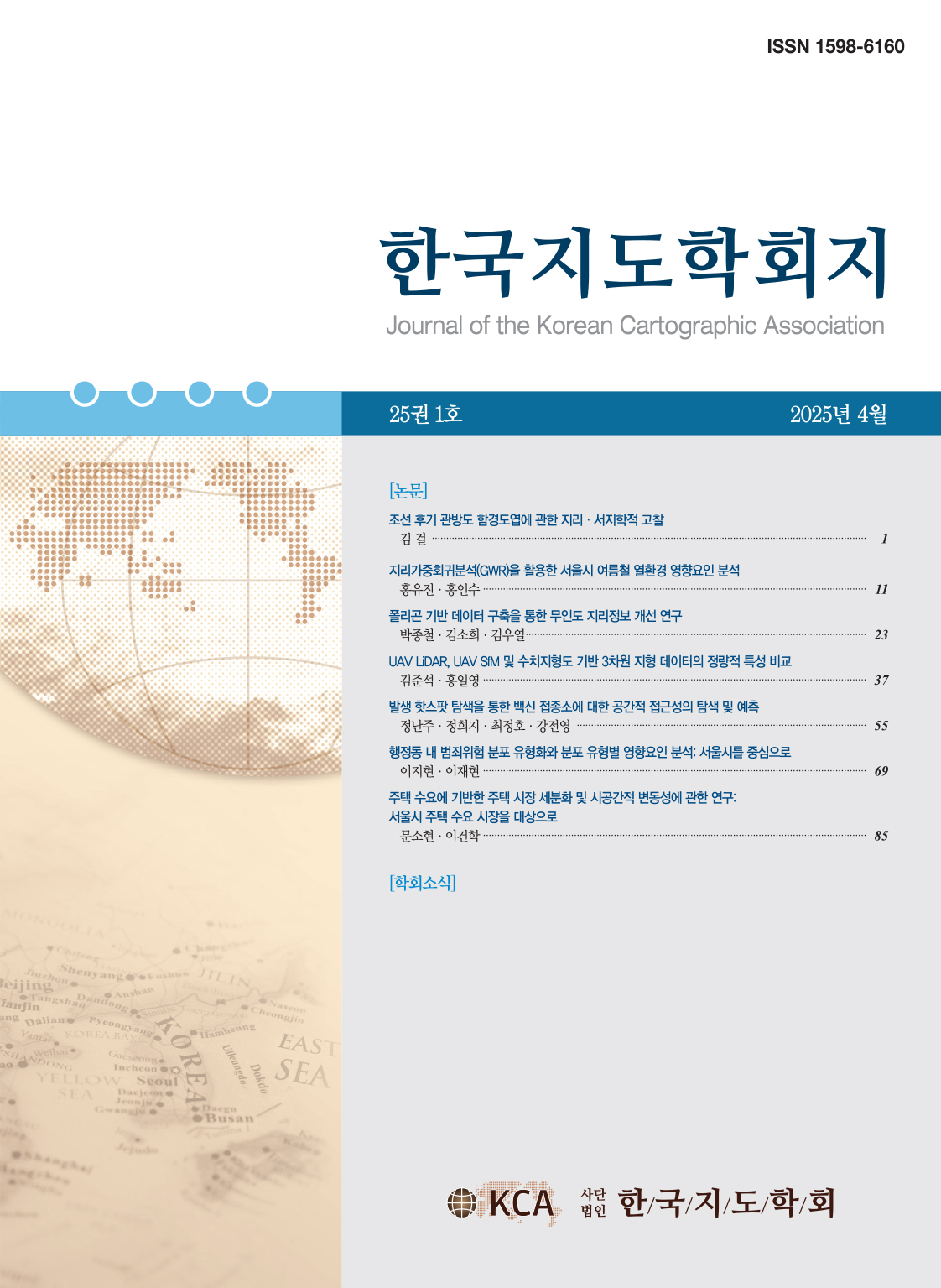Research Article
This study provides a legislative alternative to eliminate or reduce the military and security threat factors regarding Google’s request to export digital imagery outside Korea. Accordingly, a case analysis was conducted on the Capital Defense Command, one of the most important military facilities in Korea, to investigate if Google’s export of local mapping data would act as an additional threat factor in military and security aspects. As a result of the investigation, it was found that Google’s satellite imagery overlapped with exported digital images could be used for various military purposes such as infiltration paths, supply lines, and travel routes. Therefore, this study suggests legislation to introduce extraterritorial application as a legislative alternative where an entity requesting to export digital images out of the country is obliged to make individuals or organizations at home and abroad comply with the laws related to security processing to remove or reduce military and security threat factors. This alternative will impose responsibility on overseas individuals and organizations using Korean digital map images to follow the security processing-related laws, and the Korean government can evaluate the results through inspection agencies. If overseas individuals, corporations, and their branch offices fail to comply with the obligation in Korea, they should face Korean laws according to the punishment regulations: Article 109 of the Law on the Establishment and Management of Spatial Information (EMSD), Article 24 of the Protection of Military Bases and Installations Law (PMBI), and Article 7 of the Spatial Data Industry Promotion Law (SDIP).
Besides the legislative alternative, an intergovernmental negotiation on the “E-commerce Trade Law” began recently (Oct. 2019). The paradigm shift toward “digital trade” is expected to occur. Eventually, it is expected that follow-up studies will investigate measures to expand economic exchanges with balanced perspectives while eliminating extra military and security risk factors.
- 강지훈·문상호, 2015, “구글맵스 전자문화지도 기반의 학술지 지도 구현,” 한국정보통신학회논문지, 19(4), 864-870.
- 국토교통부, 2016a, “지도 국외 반출과 협의과정,” 1-4.
- 국토교통부, 2016b, “지도 국외 반출이 국내 산업에 미치는 영향 예측,” 1-4.
- 국토지리정보원, 2014, 「대축척 수치지도 정확도 재정립 연구」.
- 국토지리정보원, 2018, “지도반출 관련 협의체 각 부처와 협의과정,” 국토지리정보원 공간영상과, 1-4.
- 국회도서관, 2017a, “국가공간정보 관련 법제,” 법률정보실, 법률정보개발과, 3-25.
- 국회도서관, 2017b, “미국의 군사공간정보관련 입법례,” 법률정보실 외국법률정보과, 1-5.
- 국회도서관, 2017c, “일본의 군사공간정보관련 입법례,” 의회정보실 국외정보과, 1-11.
- 국회도서관, 2017d, “중국의 군사공간정보관련 입법례,” 의회정보실 국외정보과, 1-5.
- 국회입법조사처, 2016, “지도 해외 반출 사례조사,” 경제사업조사실 국토해양팀, 1-5.
- 국회입법조사처, 2017a, “국내 인터넷 규제의 역외적용 한계와 개선 과제,” 과학방송통신팀, 52-56.
- 국회입법조사처, 2017b, “군사공간정보관련,” 정치행정조사실 외교안보팀, 1-6.
- 국회입법조사처, 2017c, “법률의 역외적용 입법례,” 정치행정조사실 외교안보팀, 1-4.
- 김종구, 2005, “형법(刑法)의 역외적용(域外適用)과 소극적 속인주의(屬人主義)-일본의 법제와 비교법적 관점에서,” 법조, 54(12), 144-167.
- 문정균・유선봉, 2019. “토지이용규제지도의 문제점과 개선방안: 법과 행정절차의 개선을 중심으로,” 한국지도학회지, 19(3), 75-86.
- 미래안보포럼, 2018, “대한민국에서 Google Map Service 제한과 문제점에 관한 연구,” 대한민국국회, 국회사무처, 1-56.
- 박경, 2011, “구글사의 위성영상과 미국의 지명위원회 데이터베이스에 나타난 일본식 지명연구: 미국 군사지도와의 관련성 측면에서,” 한국지도학회지, 11(2), 39-49.
- 박찬수, 2009, “수치지형도를 이용한 대용량 지형정보의 실시간 시각화 기법개발,” 부경대학교 석사학위논문.
- 박현진, 2007, “독도 영유권과 지도・해도의 증거능력・증명력,” 국제법학회논총, 52(1), 89-128.
- 배기형, 2019, “군사기밀 유출 차단을 위한 군사기밀보호법 개정방안 연구,” 국민대학교 석사학위논문.
- 석광현・정순섭, 2010, “국제자본시장법의 서론적 고찰: 역외적용 및 역외투자자문업자 등의 특례를 중심으로,” 증권법연구, 11(2), 27-82.
- 안양희, 2013, “급경사지형 3차원 가시화 영상의 품질향상방안,” 경기대학교 석사학위논문.
- 안준형, 2016, “사이버테러 규제입법과 국내법의 역외적용: 보호주의 관할권의 행사기준을 중심으로,” 한국군사학논집, 72(3), 25-52.
- 양윤정, 2010, “미국의회도서관 소장 19세기 후반 한반도 비밀군사지도,” 성신여자대학교 박사학위논문.
- 원상철, 2018, “미국 연방증권법 사기방지 규정의 역외적용에 관한 고찰,” 법이론실무연구, 6(2), 197-224.
- 윤종수, 2010, “인터넷에서의 국가관할과 국내법의 역외적용,” 공법연구, 39, 27-58.
- 이수인, 2015, “군사기밀보호법 위반행위의 실태와 대응방안,” 동국대학교 석사학위논문.
- 이영대, 2017, “구글의 ‘창’, 코리아아의 '방패'-공간지리정보 공개논의를 중심으로,” 법무법인수호, 1-137.
- 이한영, 2018, “역외적용 및 로컬서버요건의 통상규범 양립성에 관한 고찰,” 정보통신정책연구, 25(4), 101-135.
- 이희옥, 2018, “빅데이터 환경에서 정보주권의 의미 분석과 법적 대응,” 한양대학교 박사학위논문.
- 임재동, 2016, “표적정보 활용을 위한 비접근지역 정사영상 제작 연구,” 서울시립대학교 석사학위논문
- 전민철, 2017, “경쟁법의 역외적용에 관한 고찰-미국, EU의 관련 입법과 사례를 중심으로,” 연세법학, 29, 209-239.
- 정인훈・박홍기・김영단·최윤수, 2013, “공간정보산업 활성화를 위한 공간정보 보안관리체계의 개선전략-공간정보의 생산, 관리, 보급 기관을 중심으로,” 한국공간정보학회지, 21(6), 33-42.
- 조아라・박재현, 2010, “안드로이드 플랫폼 기반의 구글맵 연동 어플리케이션 개발,” 한국통신학회 학술대회논문집, 456-457.
- 최승필, 2009, “경쟁법의 역외적용에 대한 법적검토-역외적용 이론의 발전 및 적용상의 문제점을 중심으로,” 외법논집, 33(1), 205-233.
- 최지현・윤희용, 2014, “구글 맵 기반 안심귀가 시스템,” 한국컴퓨터정보학회 학술발표논문집, 22(1), 473-476.
- 황성한・김만규, 2015, “한국 군사지리학의 발전방향에 관한 연구,” 한국지역지리학회지, 21(1), 176-191.
- Branson, S., Wegner, J.D., Hall, D., Lang, N., Schindler, K., and Perona, P., 2018, From Google Maps to a fine-grained catalog of street trees, ISPRS Journal of Photogrammetry and Remote Sensing, 135, 13-30.10.1016/j.isprsjprs.2017.11.008
- Burney, A., Asif, M., Abbas, Z., and Burney, S., 2017, Google Maps security concerns, Journal of Computer and Communications, 6(1), 275-283.10.4236/jcc.2018.61027
- Cerba, O. and Cepicky J., 2012, Web services for thematic maps, in Peterson, M. ed., Online Maps with APIs and WebServices, Lecture Notes in Geoinformation and Cartography, Berlin, Heidelberg: Springer, 141-155.10.1007/978-3-642-27485-5_10
- Cobb, M.A., Chung, M.J., Foley III, H., Petry, F.E., Shaw, K.B., and Miller, H.V., 1998, A rule-based approach for the conflation of attributed vector data, GeoInformatica, 2(1), 7-35.10.1023/A:1009788905049
- Han, J.-Y., Guo, J., and Chen, Y.J., 2014, Registration of vector maps based on multiple geometric features in topological aspects, Survey Review, 46(336), 219-230.10.1179/1752270613Y.0000000075
- Herbert, F., 2000, Recent maps and atlases - Map cabinet, The Cartographic Journal, 37(2), 153-156.10.1179/caj.2000.37.2.153
- Khambati, H., Boles, K., and Jetty, P., 2017, Google Maps offers a new way to evaluate claudication, Journal of Vascular Surgery, 65(5), 1467-1472.10.1016/j.jvs.2016.11.04728259575
- Kim, G., Kim, A., and Kim, Y., 2019, A new 3D space syntax metric based on 3D isovist capture in urban space using remote sensing technology, Computers, Environment and Urban Systems, 74, 74-87.10.1016/j.compenvurbsys.2018.11.009
- Krishna, B.G., Amitabh, T.P., Srinivasan, P., and Srivastava, K., 2008, DEM generation from high resolution multi-view data product, The International Archives of the Photogrammetry, Remote Sensing and Spatial Information Sciences, 37, 1099-1102.
- Lee, C.-K., Kim, T.-K., and Mjelde, J.W., 2016, Comparison of preservation values between Internet and interview survey modes: the case of Dokdo, South Korea, Journal of Environmental Planning and Management, 59(1), 22-43.10.1080/09640568.2014.980900
- Lee, H.K., 2005, Mapping the law of legalizing maps: The implications of the emerging rule of map evidence in international law, Pacific Rim Law & Policy Journal, 14(1), 159-188.
- Mitchell, G., 2003, Mapping evidence law, FSU College of Law, Public Law Research Paper, 75, 1-86.10.2139/ssrn.386860
- Moon, J.K., Sohn, H.G., Kim, S., Hong, S.H., and Cho, Y.S., 2018, Using law enforcing thematic maps for public announcements in South Korea, KSCE Journal of Civil Engineering, 22(2), 794-803.10.1007/s12205-017-1895-9
- Noh, M.-J. and Howat, I.M., 2015, Automated stereo- photogrammetric DEM generation at high latitudes: Surface Extraction with TIN-based Search-space Minimization (SETSM) validation and demonstration over glaciated regions, GIScience & Remote Sensing, 52(2), 198-217.10.1080/15481603.2015.1008621
- Rousseaux, F. and Lhoste, K., 2009, Rapid software prototyping using Ajax and Google Maps API, Proceedings, Second International Conferences on Advances in Computer-Human Interactions, February 1-7, Cancun, Mexico, 317-323.10.1109/ACHI.2009.68
- Zhu, C., Shi, W., Li, Q., Wang, G., Cheung, T., Dai, E., and Shea, G., 2005, Estimation of average DEM accuracy under linear interpolation considering random error at the nodes of TIN model, International Journal of Remote Sensing, 26(24), 5509-5523.10.1080/10245330500169029
- Zhu, X., and Zhou, C., 2009, POI inquiries and data update based on LBS, Proceedings, 2009 International Symposium on Information Engineering and Electronic Commerce, May 16-17, Ternopil, Ukraine, 730-734.10.1109/IEEC.2009.159PMC2774793
- 국가법령정보센터, http://www.law.go.kr
- 데일리한국, 2016년 7월 18일, “ ‘포켓몬 고’ 한국서 불통 왜?…이해진 “구글, 한국법 지켜라” 쓴소리”
- 한국일보, 2016년 11월 18일, “정부, 구글 지도 반출 불허... 네이버・카카오 “환영” ”
- 조선일보, 2019년 8월 27일, “구글맵, 독도는 ‘리앙쿠르 암초’, 동해는 ‘일본해’로 표기 多”
- Publisher :The Korean Cartographic Association
- Publisher(Ko) :한국지도학회
- Journal Title :Journal of the Korean Cartographic Association
- Journal Title(Ko) :한국지도학회지
- Volume : 20
- No :1
- Pages :13-24
- DOI :https://doi.org/10.16879/jkca.2020.20.1.013



 Journal of the Korean Cartographic Association
Journal of the Korean Cartographic Association





